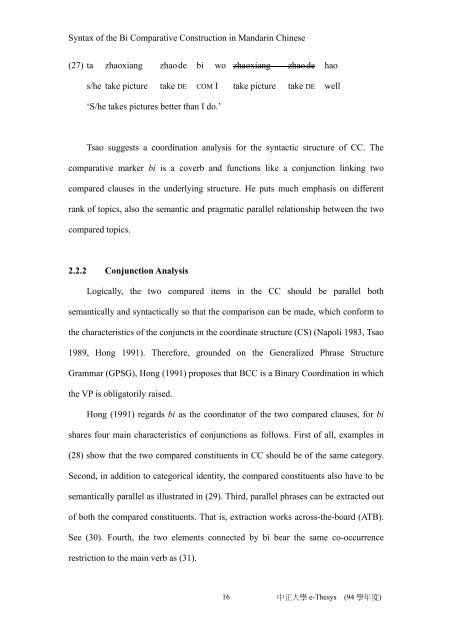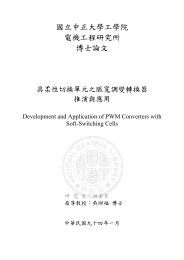Syntax of the Bi Comparative Construction in Mandarin Chinese
Syntax of the Bi Comparative Construction in Mandarin Chinese
Syntax of the Bi Comparative Construction in Mandarin Chinese
Create successful ePaper yourself
Turn your PDF publications into a flip-book with our unique Google optimized e-Paper software.
<strong>Syntax</strong> <strong>of</strong> <strong>the</strong> <strong>Bi</strong> <strong>Comparative</strong> <strong>Construction</strong> <strong>in</strong> Mandar<strong>in</strong> Ch<strong>in</strong>ese<br />
(27) ta zhaoxiang zhao de bi wo zhaoxiang zhao de hao<br />
s/he take picture take DE COM I take picture take DE well<br />
‘S/he takes pictures better than I do.’<br />
Tsao suggests a coord<strong>in</strong>ation analysis for <strong>the</strong> syntactic structure <strong>of</strong> CC. The<br />
comparative marker bi is a coverb and functions like a conjunction l<strong>in</strong>k<strong>in</strong>g two<br />
compared clauses <strong>in</strong> <strong>the</strong> underly<strong>in</strong>g structure. He puts much emphasis on different<br />
rank <strong>of</strong> topics, also <strong>the</strong> semantic and pragmatic parallel relationship between <strong>the</strong> two<br />
compared topics.<br />
2.2.2 Conjunction Analysis<br />
Logically, <strong>the</strong> two compared items <strong>in</strong> <strong>the</strong> CC should be parallel both<br />
semantically and syntactically so that <strong>the</strong> comparison can be made, which conform to<br />
<strong>the</strong> characteristics <strong>of</strong> <strong>the</strong> conjuncts <strong>in</strong> <strong>the</strong> coord<strong>in</strong>ate structure (CS) (Napoli 1983, Tsao<br />
1989, Hong 1991). Therefore, grounded on <strong>the</strong> Generalized Phrase Structure<br />
Grammar (GPSG), Hong (1991) proposes that BCC is a <strong>Bi</strong>nary Coord<strong>in</strong>ation <strong>in</strong> which<br />
<strong>the</strong> VP is obligatorily raised.<br />
Hong (1991) regards bi as <strong>the</strong> coord<strong>in</strong>ator <strong>of</strong> <strong>the</strong> two compared clauses, for bi<br />
shares four ma<strong>in</strong> characteristics <strong>of</strong> conjunctions as follows. First <strong>of</strong> all, examples <strong>in</strong><br />
(28) show that <strong>the</strong> two compared constituents <strong>in</strong> CC should be <strong>of</strong> <strong>the</strong> same category.<br />
Second, <strong>in</strong> addition to categorical identity, <strong>the</strong> compared constituents also have to be<br />
semantically parallel as illustrated <strong>in</strong> (29). Third, parallel phrases can be extracted out<br />
<strong>of</strong> both <strong>the</strong> compared constituents. That is, extraction works across-<strong>the</strong>-board (ATB).<br />
See (30). Fourth, <strong>the</strong> two elements connected by bi bear <strong>the</strong> same co-occurrence<br />
restriction to <strong>the</strong> ma<strong>in</strong> verb as (31).<br />
16<br />
中正大學 e-Thesys (94 學年度)





